当前位置:网站首页>89 logistic回歸用戶畫像用戶響應度預測
89 logistic回歸用戶畫像用戶響應度預測
2022-04-23 02:02:00 【THE ORDER】
logistic回歸篇章
數據集接應上一節數據集合,本次的分析是從用戶是否為高響應用戶進行劃分,使用logistic回歸對用戶進行響應度預測,得到響應的概率。線性回歸,參考上一篇章
1 讀取和預覽數據
對數據進行加載讀取,數據依舊是脫敏數據,
file_path<-"data_response_model.csv" #change the location
# read in data
options(stringsAsFactors = F)
raw<-read.csv(file_path) #read in your csv data
str(raw) #check the varibale type
View(raw) #take a quick look at the data
summary(raw) #take a quick look at the summary of variable
# response variable
View(table(raw$dv_response)) #Y
View(prop.table(table(raw$dv_response))) #Y frequency
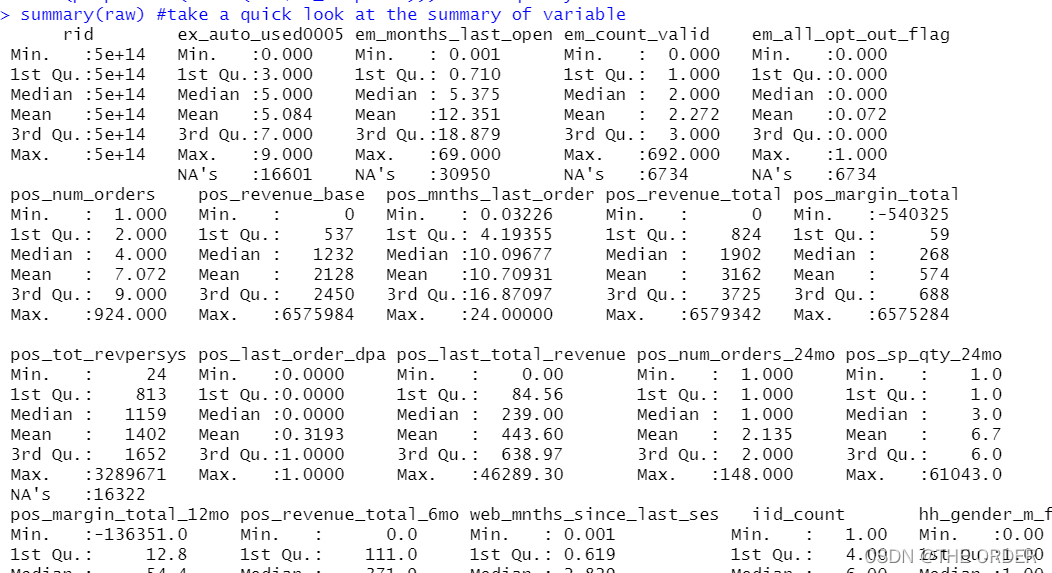
根據業務確定,數據的y值是響應率是dv_response,並觀察其情况

2 劃分數據
依舊把數據劃分為三部分,分別為訓練集,驗證集和測試集。
#Separate Build Sample
train<-raw[raw$segment=='build',] #select build sample, it should be random selected when you build the model
View(table(train$segment)) #check segment
View(table(train$dv_response)) #check Y distribution
View(prop.table(table(train$dv_response))) #check Y distribution
#Separate invalidation Sample
test<-raw[raw$segment=='inval',] #select invalidation(OOS) sample
View(table(test$segment)) #check segment
View(prop.table(table(test$dv_response))) #check Y distribution
#Separate out of validation Sample
validation<-raw[raw$segment=='outval',] #select out of validation(OOT) sample
View(table(validation$segment)) #check segment
View(prop.table(table(validation$dv_response))) #check Y distribution
3 profilng制作
對數據即中的響應率進行求和,原數據中高響應客戶為1,低響應客戶為0.求和的總數就是高響應客戶數,length就是總記錄數,求出其平均數即為總體平均數
# overall performance
overall_cnt=nrow(train) #calculate the total count
overall_resp=sum(train$dv_response) #calculate the total responders count
overall_resp_rate=overall_resp/overall_cnt #calculate the response rate
overall_perf<-c(overall_count=overall_cnt,overall_responders=overall_resp,overall_response_rate=overall_resp_rate) #combine
overall_perf<-c(overall_cnt=nrow(train),overall_resp=sum(train$dv_response),overall_resp_rate=sum(train$dv_response)/nrow(train)) #combine
View(t(overall_perf)) #take a look at the summary

這裏做的劃分如同上一章節的劃分lift圖制作,也可用sql語句來寫,如同group by,計算出每組的平均響應率與總體響應率的比較。
在library之前,請先下載plyr包,寫sql需下載sqldf
install.packages(“sqldf”)
library(plyr) #call plyr
?ddply
prof<-ddply(train,.(hh_gender_m_flag),summarise,cnt=length(rid),res=sum(dv_response)) #group by hh_gender_m_flg
View(prof) #check the result
tt=aggregate(train[,c("hh_gender_m_flag","rid")],by=list(train[,c("hh_gender_m_flag")]),length) #group by hh_gender_m_flg
View(tt)
#calculate the probablity
#prop.table(as.matrix(prof[,-1]),2)
#t(t(prof)/colSums(prof))
prof1<-within(prof,{res_rate<-res/cnt
index<-res_rate/overall_resp_rate*100
percent<-cnt/overall_cnt
}) #add response_rate,index, percentage
View(prof1) #check the result
library(sqldf)
#整型乘浮點型變浮點數據
sqldf("select hh_gender_m_flag,count() as cnt,sum(dv_response)as res,1.0sum(dv_response) /count(*) as res_rate from train group by 1 ")
缺失值也能作為特征的一部分,同樣可以對缺失值進行lift比較
nomissing<-data.frame(var_data[!is.na(var_data$em_months_last_open),]) #select the no missing value records
missing<-data.frame(var_data[is.na(var_data$em_months_last_open),]) #select the missing value records
###################################### numeric Profiling:missing part #############################################################
missing2<-ddply(missing,.(em_months_last_open),summarise,cnt=length(dv_response),res=sum(dv_response)) #group by em_months_last_open
View(missing2)
missing_perf<-within(missing2,{res_rate<-res/cnt
index<-res_rate/overall_resp_rate*100
percent<-cnt/overall_cnt
var_category<-c('unknown')
}) #summary
View(missing_perf)

這裏對非缺失值數據進行了劃分,將非缺失值數據,按照十分比特數劃分成了10等分。分別計算其總記錄數和總高響應客戶數量
nomissing_value<-nomissing$em_months_last_open #put the nomissing values into a variable
#method1:equal frequency
nomissing$var_category<-cut(nomissing_value,unique(quantile(nomissing_value,(0:10)/10)),include.lowest = T)#separte into 10 groups based on records
class(nomissing$var_category)
View(table(nomissing$var_category)) #take a look at the 10 category
prof2<-ddply(nomissing,.(var_category),summarise,cnt=length(dv_response),res=sum(dv_response)) #group by the 10 groups
View(prof2)

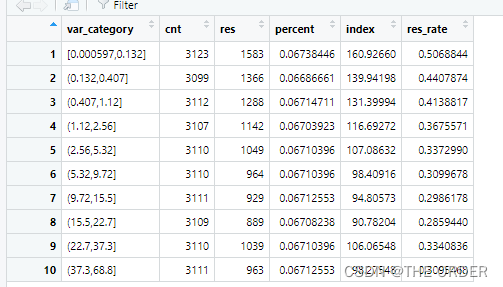
再次對劃分為10等分的數據每一組都進行lift計算,比較每組的平均高響應用戶數與總體的用戶數的比值。大於100%就是高於總體錶現的客戶標簽
nonmissing_perf<-within(prof2,
{res_rate<-res/cnt
index<-res_rate/overall_resp_rate*100
percent<-cnt/overall_cnt
}) #add resp_rate,index,percent
View(nonmissing_perf)
#set missing_perf and non-missing_Perf together
View(missing_perf)
View(nonmissing_perf)
em_months_last_open_perf<-rbind(nonmissing_perf,missing_perf[,-1]) #set 2 data together
View(em_months_last_open_perf)

4 缺失值,异常值處理
1 少於3%直接删除或者中比特數,平均數填補
2 3%——20%删除或knn,EM回歸填補
3 20%——50% 多重插補
4 50——80%缺失值分類法
5 高於80%丟弃,數據太不准確了,分析失誤性很大
异常值通常用蓋帽法解决
numeric variables
train$m2_em_count_valid <- ifelse(is.na(train$em_count_valid) == T, 2, #when em_count_valid is missing ,then assign 2
ifelse(train$em_count_valid <= 1, 1, #when em_count_valid<=1 then assign 1
ifelse(train$em_count_valid >=10, 10, #when em_count_valid>=10 then assign 10
train$em_count_valid))) #when 1<em_count_valid<10 and not missing then assign the raw value
summary(train$m2_em_count_valid) #do a summary
summary(train$m1_EM_COUNT_VALID) #do a summary
5 模型擬合
根據業務選取最有價值的變量
library(picante) #call picante
var_list<-c('dv_response','m1_POS_NUM_ORDERS_24MO',
'm1_POS_NUM_ORDERS',
'm1_SH_MNTHS_LAST_INQUIRED',
'm1_POS_SP_QTY_24MO',
'm1_POS_REVENUE_TOTAL',
'm1_POS_LAST_ORDER_DPA',
'm1_POS_MARGIN_TOTAL',
'm1_pos_mo_btwn_fst_lst_order',
'm1_POS_REVENUE_BASE',
'm1_POS_TOT_REVPERSYS',
'm1_EM_COUNT_VALID',
'm1_EM_NUM_OPEN_30',
'm1_POS_MARGIN_TOTAL_12MO',
'm1_EX_AUTO_USED0005_X5',
'm1_SH_INQUIRED_LAST3MO',
'm1_EX_AUTO_USED0005_X789',
'm1_HH_INCOME',
'm1_SH_INQUIRED_LAST12MO',
'm1_POS_LAST_TOTAL_REVENUE',
'm1_EM_ALL_OPT_OUT_FLAG',
'm1_POS_REVENUE_TOTAL_6MO',
'm1_EM_MONTHS_LAST_OPEN',
'm1_POS_MNTHS_LAST_ORDER',
'm1_WEB_MNTHS_SINCE_LAST_SES') #put the variables you want to do correlation analysis here
制作相關系數矩陣,根據相關性篩選變量相關的,共線性選擇標識變量法或啞變量法,logistic回歸可使用IV值選擇變量
corr_var<-train[, var_list] #select all the variables you want to do correlation analysis
str(corr_var) #check the variable type
correlation<-data.frame(cor.table(corr_var,cor.method = 'pearson')) #do the correlation
View(correlation)
cor_only=data.frame(row.names(correlation),correlation[, 1:ncol(corr_var)]) #select correlation result only
View(cor_only)
選擇完,准備放到模型裏面的變量
var_list<-c('m1_WEB_MNTHS_SINCE_LAST_SES',
'm1_POS_MNTHS_LAST_ORDER',
'm1_POS_NUM_ORDERS_24MO',
'm1_pos_mo_btwn_fst_lst_order',
'm1_EM_COUNT_VALID',
'm1_POS_TOT_REVPERSYS',
'm1_EM_MONTHS_LAST_OPEN',
'm1_POS_LAST_ORDER_DPA'
) #put the variables you want to try in model here
mods<-train[,c(‘dv_response’,var_list)] #select Y and varibales you want to try
str(mods)
非標准化擬合,擬合後再使用逐步回歸法進行篩選變量
mods<-train[,c('dv_response',var_list)] #select Y and varibales you want to try
str(mods)
(model_glm<-glm(dv_response~.,data=mods,family =binomial(link ="logit"))) #logistic model
model_glm
#Stepwise
library(MASS)
model_sel<-stepAIC(model_glm,direction ="both") #using both backward and forward stepwise selection
model_sel
summary<-summary(model_sel) #summary
model_summary<-data.frame(var=rownames(summary$coefficients),summary$coefficients) #do the model summary
View(model_summary)
對數據進行標准化後的建模,標准化的建模方便查看每個變量對y的影響程度
#variable importance
#standardize variable
#?scale
mods2<-scale(train[,var_list],center=T,scale=T)
mods3<-data.frame(dv_response=c(train$dv_response),mods2[,var_list])
# View(mods3)
(model_glm2<-glm(dv_response~.,data=mods3,family =binomial(link ="logit"))) #logistic model
(summary2<-summary(model_glm2))
model_summary2<-data.frame(var=rownames(summary2$coefficients),summary2$coefficients) #do the model summary
View(model_summary2)
model_summary2_f<-model_summary2[model_summary2$var!='(Intercept)',]
model_summary2_f$contribution<-abs(model_summary2_f$Estimate)/(sum(abs(model_summary2_f$Estimate)))
View(model_summary2_f)
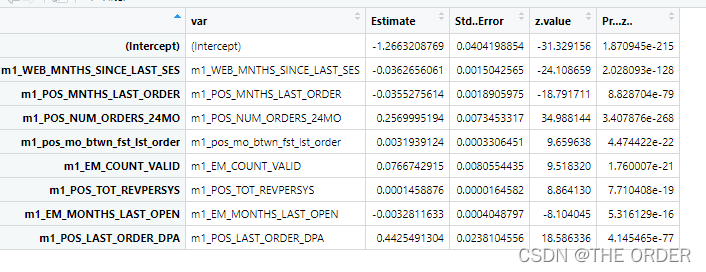
6 模型評估
回歸擬合的VIF值
#Variable VIF
fit <- lm(dv_response~., data=mods) #regression model
#install.packages('car') #Install Package 'Car' to calculate VIF
require(car) #call Car
vif=data.frame(vif(fit)) #get Vif
var_vif=data.frame(var=rownames(vif),vif) #get variables and corresponding Vif
View(var_vif)
相關系數矩陣制作
#variable correlation
cor<-data.frame(cor.table(mods,cor.method = 'pearson')) #calculate the correlation
correlation<-data.frame(variables=rownames(cor),cor[, 1:ncol(mods)]) #get correlation only
View(correlation)

最後制作ROC曲線,對模型畫ROC曲線圖,觀察其效果
library(ROCR)
#### test data####
pred_prob<-predict(model_glm,test,type='response') #predict Y
pred_prob
pred<-prediction(pred_prob,test$dv_response) #put predicted Y and actual Y together
pred@predictions
View(pred)
perf<-performance(pred,'tpr','fpr') #Check the performance,True positive rate
perf
par(mar=c(5,5,2,2),xaxs = "i",yaxs = "i",cex.axis=1.3,cex.lab=1.4) #set the graph parameter
#AUC value
auc <- performance(pred,"auc")
unlist(slot(auc,"y.values"))
#plotting the ROC curve
plot(perf,col="black",lty=3, lwd=3,main='ROC Curve')

#plot Lift chart
perf<-performance(pred,‘lift’,‘rpp’)
plot(perf,col=“black”,lty=3, lwd=3,main=‘Lift Chart’)

7 總體劃分用戶群lift圖

pred<-predict(model_glm,train,type='response') #Predict Y
decile<-cut(pred,unique(quantile(pred,(0:10)/10)),labels=10:1, include.lowest = T) #Separate into 10 groups
sum<-data.frame(actual=train$dv_response,pred=pred,decile=decile) #put actual Y,predicted Y,Decile together
decile_sum<-ddply(sum,.(decile),summarise,cnt=length(actual),res=sum(actual)) #group by decile
decile_sum2<-within(decile_sum,
{res_rate<-res/cnt
index<-100*res_rate/(sum(res)/sum(cnt))
}) #add resp_rate,index
decile_sum3<-decile_sum2[order(decile_sum2[,1],decreasing=T),] #order decile
View(decile_sum3)
采用的是十分比特數劃分,等記錄數的劃分客戶群體,可以發現1-10個層次的用戶,真實響應率lift值不錯。
將回歸方程貼出來
ss <- summary(model_glm) #put model summary together
ss
which(names(ss)=="coefficients")
#XBeta
#Y = 1/(1+exp(-XBeta))
#output model equoation
gsub("\\+-","-",gsub('\\*\\(Intercept)','',paste(ss[["coefficients"]][,1],rownames(ss[["coefficients"]]),collapse = "+",sep = "*")))

版权声明
本文为[THE ORDER]所创,转载请带上原文链接,感谢
https://yzsam.com/2022/04/202204230159390970.html
边栏推荐
- K zeros after leetcode factorial function
- Analyze the advantages and disadvantages of tunnel proxy IP.
- What is an API interface?
- What categories do you need to know before using proxy IP?
- easyswoole环境配置
- The leader / teacher asks to fill in the EXCEL form document. How to edit the word / Excel file on the mobile phone and fill in the Excel / word electronic document?
- Question bank and online simulation examination for safety management personnel of hazardous chemical business units in 2022
- Communication summary between MCU and 4G module (EC20)
- MySQL basic record
- W801 / w800 WiFi socket development (I) - UDP
猜你喜欢
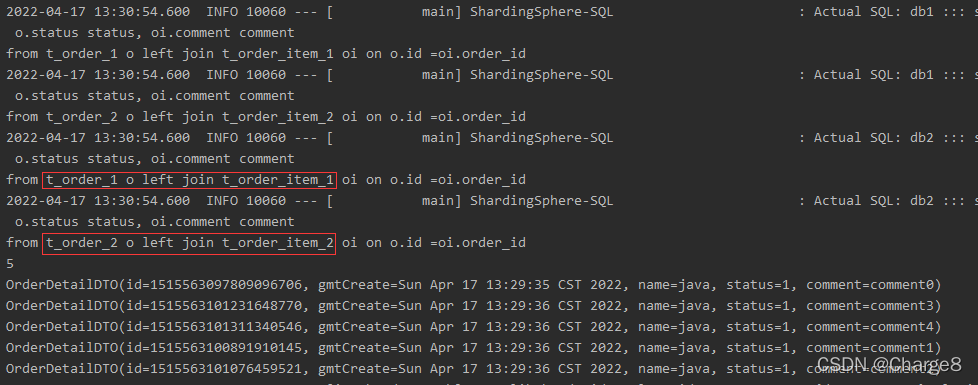
Shardingsphere broadcast table and binding table

How to choose a good dial-up server?
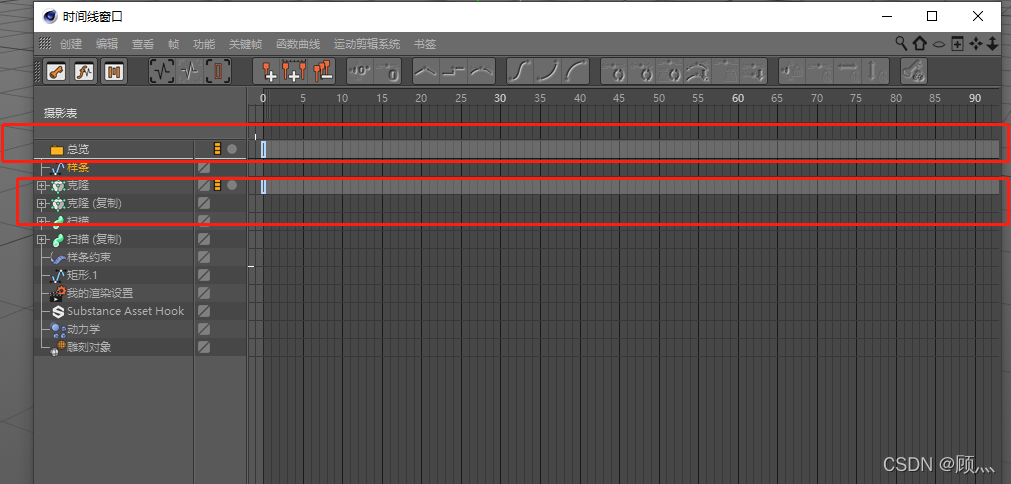
About how to import C4d animation into lumion

如何设置电脑ip?

Batch multiple files into one hex

What categories do you need to know before using proxy IP?

W801 / w800 / w806 unique ID / CPUID / flashid

有哪些业务会用到物理服务器?

Use of j-link RTT
![[experience tutorial] Alipay balance automatically transferred to the balance of treasure how to set off, cancel Alipay balance automatically transferred to balance treasure?](/img/d5/6aa14af59144b8c99aa6a367479f6b.png)
[experience tutorial] Alipay balance automatically transferred to the balance of treasure how to set off, cancel Alipay balance automatically transferred to balance treasure?
随机推荐
What is a dial-up server and what is its use?
How to choose a good dial-up server?
mb_ substr()、mb_ Strpos() function (story)
EBS:PO_ EMPLOYEE_ HIERARCHIES_ ALL
Implementation of Base64 encoding / decoding in C language
2022第六季完美童模 IPA國民賽領跑元宇宙賽道
如何“优雅”的测量系统性能
Sqlserver data transfer to MySQL
不断下沉的咖啡业,是虚假的繁荣还是破局的前夜?
Today will finally write system out. Println()
Micro build low code zero foundation introductory course
Shardingsphere read write separation
Some tips for using proxy IP.
如何设置电脑ip?
easyswoole环境配置
什么是api接口?
Is it better to use a physical machine or a virtual machine to build a website?
[Dahua cloud native] micro service chapter - service mode of five-star hotels
Makefile文件是什么?
【汇编语言】从最底层的角度理解“堆栈”